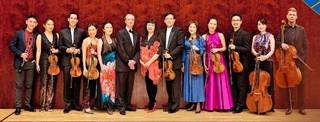|
Back
Tales of Youth, Agony and Death New York
Alice Tully Hall, Lincoln Center
04/14/2023 -
Ludwig van Beethoven: Trio for Piano, Violin and Cello in E Flat Major, Opus 1, No. 1
André Caplet: Conte fantastique
Wolfgang Amadeus Mozart: Clarinet Quintet in A Major, K. 581
Dmitri Shostakovich: Prelude and Scherzo for String Octet, Opus 11
Members of Taiwan Philharmonic Orchestra and Chamber Music Society of Lincoln Center: Julian Chun‑Yen Lai (Clarinet), Stella Chen, Danbi Um, Richard Lin, Hao‑Tung Teng, Chih‑Hong Tseng (Violins), Hsin‑Yun Huang, Grace Huang (Violas), David Finckel, Mihai Marica, Ying‑Chi Tang (Cellos), Shannon Shuen Chieh (Harp), Wu Han (Pianist)

(© Chamber Music Society of Lincoln Center)
“The soft sweet breath of a clarinet.”
Wolfgang Amadeus Mozart
“Darkness and Decay and the Red Death holding illimitable dominion over all.”
Edgar Allan Poe, The Masque of the Red Death
Rare indeed does a concert commence where one thinks, “Gee, that comical Lud Beethoven knows how to put a smile on the lips and a twinkle in the eye.”
Yet that was precisely the effect from the unique blend of soloists from the Taiwan’s National Symphony Orchestra (NSO) and the Chamber Music Society of Lincoln Center (CMS) last night. Unique but not really surprising.
The American virtuosi, graduates from Juilliard, Curtis and the like, have been in an artistic forefront, as orchestral First Chairs and stalwarts of the CMS. The orchestra of the Republic of China was founded in 1986. And while some visitors (like this writer) have basically confined themselves to the most glorious Museum in Asia, the schools and conservatories have meanwhile turned young extremely talented musicians. Practicing, studying and excelling. Not only in traditional Chinese music–where the Republic of China keeps the faith–but Western-style music.
The result last night was a blend of 18th Century and 20th Century chamber works, where they showed off some remarkable skills.
The special skill was Taiwanese clarinetist Julien Chun‑Yen Lai in Mozart’s all too familiar Quintet. And familiar for good reason. Mozart was not only great friends with its dedicatee, but he loved the sounds of this newly-invented instrument. Thus it takes more than a virtuoso to handle this work. After all, Mozart never called it a “Clarinet Quintet”. All five instruments share in the joy of its skills.
But admittedly, Mr. Lai possesses that very special skill: the skill of grace. He could run up and down the scales with extreme confidence and undoubted skill. Yet in both the Menuetto and the multi‑mood finale, he easily changed colors, fused with the quartet and offered the most fluid reading. As for the Larghetto, Mozart in his last two years never was more inspired. And Mr. Lai exploited the tender notes with all the requisite tenderness.
The other 18th Lai Century piece was Beethoven’s String Trio, played with more than mere élan by Chih‑Hong Tseng, David Finckel and the world-renowned pianist Wu Han. The trio played all four movements with that most un-Beethoven-ish word “mirth.” Unlike his later works, the notes here burst out with spontaneity, electricity and, in the Presto Finale, a series of self-mocking jokes.
One still wondered, epistemologically speaking, whether the 23‑year‑old Beethoven in the darkest most distant regions of his brain, simultaneously conceived a Grosse Fuge or Hammerklavier. It seems unlikely, but Beethoven was a most unlikely human.
The most beautiful solos came from NSO harpist Shannon Shuen Chieh in André Caplet’s Conte fantastique for Harp, Two Violins, Viola and Cello. It was also the most frustrating music for the audience.
A few weeks ago, the Metropolitan Opera Chamber Ensemble played the same work–but they had the most sensible opening. Caplet’s work was virtually a literal retelling of Edgar Allen Poe’s Masque of the Red Death. Everything from the demonic ball to the entrance of Death, to the tolling of the church bell to the Terror.
The Met sagaciously read parts of Poe’s masterpiece before and during the work. So after realizing the grotesquerie of the tale, one felt the horror with the music.
Here, Ms. Chieh and the soloists played in most blatant possible way. The ball was danceable, Ms. Chieh played with strange harmonics, with harmonic glissandi and resounding knocking with the other instruments.
If only the audience hadn’t heard the work as just another “pretty piece.” If only Poe’s demons have been narrated, in English and Mandarin, to give the fiendish reason for the work.
The finale brought together all the strings for a truly rare Shostakovich work, written at 19. And truly precocious. The Adagio of the two movements was appropriately somber. But the Scherzo was a whizz‑bang finale with strings buzzing, snapping, offering quarter‑tones and contrapuntal glissandi.
Beethoven’s first published work, opening this concert, was of 18th Century reason, contentment, joy to the world. Shostakovich’s Scherzo prefaced a world of anxiety, horror and dread. Both emotions were well envisioned by these splendid young musicians with their varied countries and multiplicity of talents.
Harry Rolnick
|